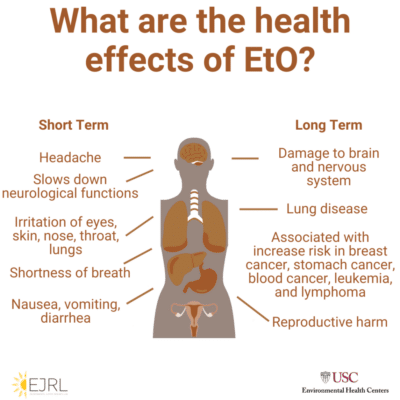- Ethylene oxide is a known carcinogenic, and workers in healthcare and sterilization facilities face increased cancer risks due to chronic long-term exposure.
- Limiting ethylene oxide emissions from the facilities is necessary to reduce cancer risks for people living, working, or going to school around these facilities, especially children.
- New EPA regulations proposed in April 2023 have made the permissible levels of ethylene oxide more stringent and want continuous air monitoring by new precision technology to advise adequate safety measures.
Ethylene oxide’s toxicity has been revised in a 2018 EPA report that found increased risks of cancers in localities where the gas was used. The gas is a standard sterilization method, and its emissions from healthcare facilities must be controlled to make the environment safe for workers in the facilities and people in the neighborhood. Find out the importance of ethylene oxide monitoring and reducing emissions.
Ethylene Oxide Uses in Healthcare Facilities
Ethylene oxide (EtO) gas is used for surgical equipment sterilization and is essential to prevent disease and infection in hospitals and other healthcare facilities. EtO sterilization is used for medical and personal protective equipment used by doctors and pharmaceutical products where conventional, high-temperature steam sterilization methods are unsuitable.
These include the increasing number of plastic instruments requiring sterilization without high temperatures. Ethylene oxide is easy to use and is compatible with most materials used to make medical equipment.
Ethylene oxide is used for sterilizing nearly 50 percent of medical equipment and products in the US. About 20 billion medical devices are sterilized by ethylene oxide annually in the country.
The type of equipment where ethylene oxide is used are heart valves, pacemakers, catheters, syringes, ventilators, equipment for intravenous infusions, surgical kits, and ointments. Ethylene oxide can be used for drapes, gowns, and bandages, where hydrogen peroxide vapor is unsuitable.
When ethylene oxide is used at 100 percent, removing residue requires a long aeration time as it is hazardous.
Why is Ethylene Oxide Hazardous?
Ethylene oxide emissions are considered an occupational risk for people who handle it and those who live, work, or spend time close to healthcare facilities. It takes months to break down in the ambient air, which poses many risks for people.
EtO is a flammable gas above 51.3ºF (10.7ºC). However, the health effects are the primary concern in using this gas. Ethylene oxide is considered an air toxin and a health hazard.
Health Effects

Infographic from USC Environmental Health Centers. Click here to view the full article
Acute exposure to ethylene oxide causes skin, eyes, gastrointestinal, and respiratory tract irritation. Chronic inhalation causes cataracts, neurologic dysfunction, cognitive impairment, and disabling polyneuropathies. Occupation exposure to EtO is associated with increased spontaneous abortions and hematologic change. Ethylene oxide residues in implants used in surgery have caused tissue burns, and residual EtO dialysis membranes are neurotoxic.
Ethylene oxide is carcinogenic to humans and is mutagenic damaging DNA. A lifetime daily exposure to ethylene oxide increases cancer risk for personnel exposed to the gas in healthcare and sterilization procedures. Long-term exposures increase the risk of breast cancer in women. Children living or attending school near EtO facilities are particularly vulnerable since they are growing. Ethylene oxide monitoring is necessary to reduce the gas exposure risks.
Employer’s Responsibilities
Therefore, employers must ensure strict controls to ensure the ethylene oxide emissions in the air are below prescribed levels.
New PEL Levels
In April 2023, the US Environmental Protection Agency (EPA) proposed strengthening the Clean Air Act. The EPA proposal aims to reduce EtO emissions by 80 percent to make healthcare and sterilization facilities and their neighborhood significantly safer for people by reducing the cancer risk posed by ethylene oxide.
The new EPA proposal wants the permissible exposure limit (PEL) for EtO to be stricter than the prevailing US Occupational Safety and Health Administration (OSHA) recommendations of 1 ppm (parts per million) airborne TWA (total weight average) for an 8-hour work shift in a 40-hour work week. The previous OSHA PEL for shorter 15-minute TWA was 5 ppm.
The proposed EPA PEL is 10 ppb (parts per billion), far lower than current levels.
Ethylene Oxide Monitoring
Besides the new PEL, the new EPA regulations require employers to have ethylene oxide emission monitoring in facilities using the latest technology to provide accurate real-time readings of 10 ppb. Ethylene oxide is a colorless gas with a strong odor only at high concentrations, and manual detection is difficult.
Furthermore, the EPA advocates continuous air monitoring for ethylene oxide to ensure that pollution control equipment is functioning correctly.
The employers must also have the technology to monitor EtO levels below 10 ppb inside sterilization facilities.
Safety Measures
In addition, several measures are tabled by EPA to make air ethylene oxide-free for workers.
- If the levels rise above 10 ppb, all workers in the facilities must use PPE.
- The EPA also wants to reduce EtO use for each sterilization cycle. The EtO application rate must not exceed 500 ppm or (500 milligrams per liter of air).
- The EPA regulations also require air pollution control technologies, procedures, and practices, that will reduce EtO emissions.
- The pollution control equipment and sterilization process must also be tested. Employers must submit these test data twice a year to EPA.
- The US Food and Drug Administration would like healthcare facilities to find alternatives to EtO gas. However, currently, some devices have no other alternate sterilization methods.
The current OSHA recommendations for protective gear use, air monitoring, and pollution control measures are available in the Fact Sheet.
Reducing EtO Emissions
According to a CNN report, many facilities using ethylene oxide sterilization are already implementing the new proposed measures and have managed to lower ethylene oxide emissions.
The new regulations have prioritized precision monitoring to check ethylene oxide levels. In addition to continuous monitoring, sometimes spot checks by personnel might be necessary. Interscan offers portable precision tools that give readings within seconds. Its GasD 8000 Series Portable Gas Analyzers offer two options with a resolution of 1 ppb as the new EPA prescribes and can measure ranges between 0-1000 ppb and 0-2000 ppb.
Monitoring toxic gases like ethylene oxide is the first step to making healthcare and sterilization facilities safer for workers and the neighborhood. The additional investment in them and other polluting control measures are outweighed by the benefits they provide.
Written by:
 Vijayalaxmi Kinhal
Vijayalaxmi Kinhal
Science Writer, CID Bio-Science
Ph.D. Ecology and Environmental Science, B.Sc Agriculture
Sources
CDC. (2016, September 18). Ethylene Oxide “Gas” Sterilization. Retrieved from https://www.cdc.gov/infectioncontrol/guidelines/disinfection/sterilization/ethylene-oxide.html
ChemicalDafetyFacts.org. (2023, May 23). Ethylene Oxide. Retrieved from https://www.chemicalsafetyfacts.org/chemicals/ethylene-oxide/
EPA. (2023, April 11). Actions to Protect Workers and Communities from Ethylene Oxide (EtO) Risk. Retrieved from https://www.epa.gov/hazardous-air-pollutants-ethylene-oxide/actions-protect-workers-and-communities-ethylene-oxide-eto
EPA. (n.d.) EPA Proposes to Strengthen Clean Air Act Standards for Ethylene Oxide from Commercial Sterilization Facilities: Fact Sheet. Retrieved from https://www.epa.gov/system/files/documents/2023-04/Fact%20Sheet%20Proposal%20to%20Address%20EtO%20Risks%20from%20Commercial%20Sterilizers.pdf
Goodman, B. (2023, April 11). EPA proposes new regulations on toxic gas used to sterilize spices and medical equipment. Retrieved from https://edition.cnn.com/2023/04/11/health/epa-regulations-ethylene-oxide-gas/index.html
OSHA. (n.d.). OSHA Fact Sheet. Retrieved from https://www.osha.gov/sites/default/files/publications/ethylene-oxide-factsheet.pdf
Rutala, W. A., & Weber, D. J. (2015). Disinfection, sterilization, and control of hospital waste. In Mandell, Douglas, and Bennett (Eds.), Principles and Practice of Infectious Diseases (Eight Edition). https://doi.org/10.1016/b978-1-4557-4801-3.00301-5

